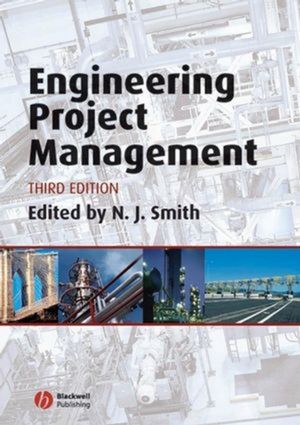Engineering Project Management, 3rd EditionISBN: 978-1-4051-6802-1
Paperback
400 pages
December 2007, Wiley-Blackwell
 |
||||||
1.1 The Function of Project Management.
1.2 Projects.
1.3 Project Management.
1.4 Project Initiation.
1.5 Project Risks.
1.6 Project Objectives.
1.7 Project Success.
CHAPTER 2 VALUE MANAGEMENT.
2.1 Introduction2.2 Definitions.
2.3 Why and When to Apply VM.
2.4 How to Apply VM.
2.5 Reviews.
2.6 Procedures and Techniques.
2.7 Benefits of Value Management.
2.8 Summary.
CHAPTER 3 CASH FLOW, PROJECT APPRAISAL AND RISK MANAGEMENT.
3.1 Cash Flow.
3.2 Categories of Charge.
3.3 Compiling the Base-case Cash Flow.
3.4 Project Cash Flow.
3.5 Profitability Indicator.
3.6 Inflation.
3.7 Initiation.
3.8 Sanction.
3.9 Project Appraisal and Selection.
3.10 Project Evaluation.
3.11 Engineering Risk.
3.12 Risk Management.
3.13 Risk and Uncertainty Management.
CHAPTER 4 QUALITY MANAGEMENT IN PROJECTS4.1 History of Quality Management.
4.2 Definitions:4.3 Quality Planning.
4.4 Quality Management4.5 Total Quality Management (TQM).
4.6 Quality Management Systems.
4.7 Quality Manual.
4.8 International Standards for Quality.
4.9 Implementing a Project Quality System4.10 Types of Quality Related Costs.
4.11 Introducing a Quality Cost System:4.12 Example of a Typical Quality and Production Format.
4.13 Improving Project Quality4.14 Integrating Quality into common Business Practices 4.15 Summary.
CHAPTER 5 ENVIRONMENTAL MANAGEMENT.
5.1 Environmental Impact.
5.2 Environmental Impact Assessment (EIA).
5.3 Screening.
5.4 Environmental Legislation.
5.5 Scoping.
5.6 Base Line Study.
5.7 Impact Prediction.
5.8 Environmental Impact Statement.
5.9 Presenting EIA Information5.10 Monitoring and Auditing of Environmental Impacts.
5.11 Environmental Economics5.12 Environmental Management.
CHAPTER 6 PROJECT FINANCE.
6.1 Introduction.
6.2 Definition of Project Finance.
6.3 Basic Features of Project Finance.
6.4 Short Term Financing Instruments.
6.5 Project Finance in Bundled or Portfolios of Projects.
6.6 Risks.
6.7 Financial Engineering.
6.8 Refinancing and Restructuring.
6.9 Summary.
CHAPTER 7 COST ESTIMATING IN CONTRACTS AND PROJECTS.
7.1 Cost Estimating.
7.2 Cost and Price.
7.3 Importance of the Early Estimates.
7.4 Estimating Techniques.
7.5 Suitability of Estimating Techniques to Project Stages.
7.6 Estimating for Process Plants.
7.7 Information Technology in Estimating.
7.8 Realism of Estimates.
CHAPTER 8 PROGRAMME MANAGEMENT.
8.1 Strategic Management, Managing Change and Programme Management.
8.2 Basics of Programme Management.
8.3 Defining Programme Management, Its Nature and Scope.
8.4 Project Ranking within a Programme.
8.5 Summary.
CHAPTER 9 PLANNING.
9.1 Planning.
9.2 Programming.
9.3 Network Analysis.
9.4 Updating the Network.
9.5 Resource Scheduling.
9.6 Planning with Uncertainty.
9.7 ICT for Project Planning.
9.8 The Planner and Project Teams.
CHAPTER 10 PROJECT CONTROL USING EARNED VALUE TECHNIQUES 10.1 Project Control 10.2 Earned Value Definitions.
10.3 The Theory and Development of Earned Value Analysis.
10.4 Relationship of Project Functions and Earned Value.
10.5 Value of Work Done Control.
10.6 Earned Value Analysis Techniques.
10.7 Application of EVA.
10.8 Examples of EVA.
10.9 Summary.
CHAPTER 11 CONTRACT STRATEGY AND THE CONTRACTOR SELECTION PROCESS.
11.1 Context.
11.2 Factors Affecting Strategy.
11.3 Contractual Considerations.
11.4 Contractor Choice.
11.5 Project Objectives.
11.6 Contract Selection.
11.7 Project Organisation.
11.8 Risk Allocation.
11.9 Terms of Payment.
11.10 Model or Standard Conditions of Contract.
11.11 Sub-Contracts.
CHAPTER 12 CONTRACT POLICY AND DOCUMENTS.
12.1 Tendering Procedures.
12.2 Contracting Policy.
12.3 Contract Planning.
12.4 Contractor Pre-Qualification.
12.5 Contract Documents.
12.6 Tender Review.
12.7 Tender Evaluation.
12.8 Typical Promoter Procedure.
CHAPTER 13 PROJECT DESIGN AND STRUCTURE.
13.1 Organisations.
13.2 Building Blocks of Organisations.
13.3 The Project as a Temporary Organisation.
13.4 Organisation Types.
13.5 The Matrix.
13.6 Networks.
13.7 Virtual Organisations.
13.8 Multiple Projects.
13.9 The Human Side of Structure.
13.10 Project Teams and Empowerment.
13.11 Structure in Collaborative Relationships.
13.12 Summary.
CHAPTER 14 DESIGN MANAGEMENT.
14.1 Introduction.
14.2 Understanding Design.
14.3 What Design Has To Do.
14.4 The Role of Design Management.
14.5 Managing the Project Triple Constraints.
14.6 Design Liability.
14.7 Briefing.
14.8 Interface Control.
14.9 Design for Manufacturing.
CHAPTER 15 SUPPLY CHAIN MANAGEMENT.
15.1 Introduction.
15.2 Perspectives on Terminology.
15.3 Supply Chain Strategy.
15.4 The Nature of the Organisation.
15.5 The World Class Organisation in Manufacturing.
15.6 The Project Value Chain.
15.7 Procurement and the Project Value Chain.
15.8 Prime Contracting.
15.9 The Operation of Future Construction Supply Chains.
15.10 Summary.
CHAPTER 16 PARTNERING.
16.1 Teamworking.
16.2 Supply Chain Integration.
16.3 Relational Contracting.
16.4 Partnering.
16.5 Forms of Partnering.
16.6 Establishing the Relationship.
16.7 Making the Relationship Work.
16.8 The Benefits of Partnering.
16.9 The Limitations of Partnering.
16.10 Summary.
CHAPTER 17 PRIVATE FINANCE INITIATIVE AND PUBLIC/PRIVATE PARTNERSHIP.
17.1 Concession Contracts.
17.2 Definition of BOOT Projects.
17.3 Organisational and Contractual Structure.
17.4 Concession Agreements.
17.5 Procurement of BOOT Project Strategies.
17.6 Concession Periods.
17.7 Existing Facilities.
17.8 Classification of BOOT Projects.
17.9 Projects Suitable for BOOT Strategies.
17.10 Risks Fundamental to BOOT Projects.
17.11 BOOT Package Structure.
17.12 Advantages and Disadvantages of BOOT Projects.
17.13 The Origins of PFI.
17.14 The Arguments for Privately Financed Public Services.
17.15 PFI in the UK17.16 Bidding and Competition 17.17 Output Specification.
17.18 Financing Public Private Partnerships.
CHAPTER 18 PROJECT STAKEHOLDERS.
18.1 Stakeholders.
18.2 Stakeholder Identification.
18.3 The Client.
18.4 Contractors.
18.5 Financiers.
18.6 Government.
18.7 Community.
18.8 Interest groups.
18.9 Summary.
CHAPTER 19 PROJECT MANAGEMENT IN DEVELOPING COUNTRIES.
19.1 What Makes Developing Countries Different?.
19.2 The Construction Industry in Developing Countries.
19.3 Finance and Funding.
19.4 Appropriate Technology.
19.5 Labour Intensive Construction.
19.6 Community Participation.
19.7 Technology Transfer19.8 Corruption.
19.9 The Future.
CHAPTER 20 PROJECTS IN CONTROLLED ENVIRONMENTS 2: PRINCE2.
20.1 Introduction.
20.2 Benefits and Limitations.
20.3 Project Management Standards and Methodologies.
20.4 Structure and Contents.
20.4.1 Components.
20.4.2 Processes.
20.4.3 Techniques.
20.5 Structured Walkthrough.
20.5.1 Planning Work.
20.5.2 Doing Work.
20.6 Summary.
CHAPTER 21 THE FUTURE FOR ENGINEERING PROJECT MANAGEMENT.
21.1 Key Roles in Project Management.
21.2 Guidelines for Project Management.
21.3 Project Management - The Way Ahead



